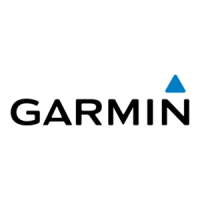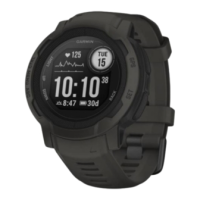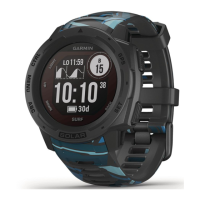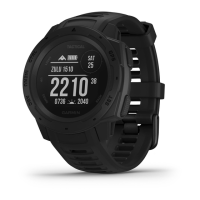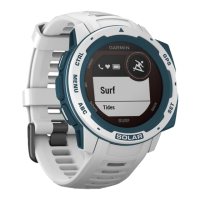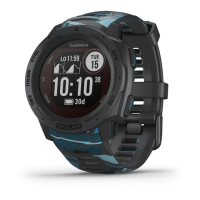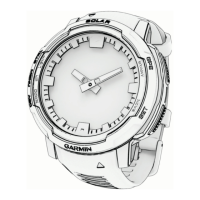Do you have a question about the Garmin INSTINCT 2X and is the answer not in the manual?
Guides the user through initial setup tasks for the watch.
Identifies and explains the function of each button on the watch.
Guides users on setting single or recurring alarms with various options.
Instructions on setting and starting countdown timers with optional features.
Guides setup for the dēzl Edition watch and its trucking-specific features.
Details on using the break planning glance to track working hours.
Step-by-step guide to starting any activity, including GPS and sensor readiness.
Options available after finishing an activity: saving, resuming, discarding, etc.
How to record outdoor track runs, including lane calibration.
Advice for accurate track run data, including GPS status and lap lane.
Advice for accurate swimming data, including interval recording and pool size.
How to calibrate treadmill distance for more accurate run data.
Steps to create a custom multisport activity with multiple sports and transitions.
How to record sets, reps, and rest times during strength training.
How to pair and use an indoor bike trainer with the watch.
How to record bouldering routes, grading, and difficulty levels.
Using the Expedition app to prolong battery life during multi-day activities.
Overview of skiing and snowboarding activities.
Steps to start a golf activity, select a course, and keep score.
Details the options available in the golf menu, like ending a round or measuring shots.
Explains the different jump types (HAHO, HALO, Static) and their requirements.
How to input details like DIP, drop altitude, and wind for jump calculations.
How to customize activities, data screens, and app lists.
How to show, hide, and arrange data fields on activity screens.
Enables automatic detection of elevation changes during activities.
Configures automatic lap marking based on distance or location.
Notifies you once when a specific value is reached (e.g., calories burned).
Notifies when a value is above or below a specified range (e.g., heart rate).
Enables multiple satellite systems for improved performance in challenging environments.
Records track points less frequently to increase battery life, reducing data quality.
Explains terms and data fields related to the Applied Ballistics feature.
Manages ballistic profiles on the watch via the AB Synapse app.
How to quickly edit range, direction of fire, and wind information.
Views data for various ranges and customizes range card fields.
Enters or selects bullet properties like caliber, manufacturer, and drag curve.
Allows editing of gun properties like muzzle velocity and sight height.
Calibrates drop scale factor for more accurate transonic range solutions.
Sets a primary device for training metrics and syncing with Garmin Connect.
Creates, finds, and schedules custom workouts or training plans.
Steps to create custom interval workouts with specific durations and rest times.
How to download and use training plans from Garmin Connect.
Setting distance, time, or pace goals for training feedback.
Steps to access and view details of saved activities like stats, heart rate, and maps.
How the watch displays and tracks new personal bests achieved during activities.
Options to delete all activities or reset totals from the history.
Customizes watch face layout, colors, and downloads new faces.
Provides quick access to health data, activities, and sensors via glances.
Estimates to track and understand training activities and race performances.
Measures maximum oxygen volume to indicate cardiovascular strength.
Assesses performance ability in real-time compared to fitness level.
Identifies intensity level where lactate accumulates, affecting muscle fatigue.
Steps to get a VO2 max. estimate for cycling activities.
Describes different training status levels like Detraining, Recovery, Productive, etc.
How heat and altitude impact performance and watch estimates.
Play an audible alert on the paired phone if it's within Bluetooth range.
Turn on the screen or LED as a flashlight.
Adjusts watch face, phone connection, sensors, and backlight for battery saving.
Changes power mode during an activity to extend battery life.
Adjusts time format, date format, time zone, and manual time settings.
Adjusts screen brightness, night vision, and timeout.
Instructions on how to connect the watch to a power source for charging.
Important notices on cleaning, avoiding chemicals, and protecting the device.
How the device checks for and installs software and course updates.
Information on watch compatibility with phones using Bluetooth technology.
Steps to restart the watch by holding the CTRL button.
Advice on changing power modes, reducing brightness, and disabling features to extend battery.
Tips for improving step count accuracy, like wearing the watch on the non-dominant wrist.
Lists and describes available data fields for various activities and categories.
Details metrics like ground contact time balance, stride length, and vertical ratio.
Explains ground contact time balance, measuring running symmetry.
Classifications for functional threshold power (FTP) estimates by sex.
Guides the user through initial setup tasks for the watch.
Identifies and explains the function of each button on the watch.
Guides users on setting single or recurring alarms with various options.
Instructions on setting and starting countdown timers with optional features.
Guides setup for the dēzl Edition watch and its trucking-specific features.
Details on using the break planning glance to track working hours.
Step-by-step guide to starting any activity, including GPS and sensor readiness.
Options available after finishing an activity: saving, resuming, discarding, etc.
How to record outdoor track runs, including lane calibration.
Advice for accurate track run data, including GPS status and lap lane.
Advice for accurate swimming data, including interval recording and pool size.
How to calibrate treadmill distance for more accurate run data.
Steps to create a custom multisport activity with multiple sports and transitions.
How to record sets, reps, and rest times during strength training.
How to pair and use an indoor bike trainer with the watch.
How to record bouldering routes, grading, and difficulty levels.
Using the Expedition app to prolong battery life during multi-day activities.
Overview of skiing and snowboarding activities.
Steps to start a golf activity, select a course, and keep score.
Details the options available in the golf menu, like ending a round or measuring shots.
Explains the different jump types (HAHO, HALO, Static) and their requirements.
How to input details like DIP, drop altitude, and wind for jump calculations.
How to customize activities, data screens, and app lists.
How to show, hide, and arrange data fields on activity screens.
Enables automatic detection of elevation changes during activities.
Configures automatic lap marking based on distance or location.
Notifies you once when a specific value is reached (e.g., calories burned).
Notifies when a value is above or below a specified range (e.g., heart rate).
Enables multiple satellite systems for improved performance in challenging environments.
Records track points less frequently to increase battery life, reducing data quality.
Explains terms and data fields related to the Applied Ballistics feature.
Manages ballistic profiles on the watch via the AB Synapse app.
How to quickly edit range, direction of fire, and wind information.
Views data for various ranges and customizes range card fields.
Enters or selects bullet properties like caliber, manufacturer, and drag curve.
Allows editing of gun properties like muzzle velocity and sight height.
Calibrates drop scale factor for more accurate transonic range solutions.
Sets a primary device for training metrics and syncing with Garmin Connect.
Creates, finds, and schedules custom workouts or training plans.
Steps to create custom interval workouts with specific durations and rest times.
How to download and use training plans from Garmin Connect.
Setting distance, time, or pace goals for training feedback.
Steps to access and view details of saved activities like stats, heart rate, and maps.
How the watch displays and tracks new personal bests achieved during activities.
Options to delete all activities or reset totals from the history.
Customizes watch face layout, colors, and downloads new faces.
Provides quick access to health data, activities, and sensors via glances.
Estimates to track and understand training activities and race performances.
Measures maximum oxygen volume to indicate cardiovascular strength.
Assesses performance ability in real-time compared to fitness level.
Identifies intensity level where lactate accumulates, affecting muscle fatigue.
Steps to get a VO2 max. estimate for cycling activities.
Describes different training status levels like Detraining, Recovery, Productive, etc.
How heat and altitude impact performance and watch estimates.
Play an audible alert on the paired phone if it's within Bluetooth range.
Turn on the screen or LED as a flashlight.
Adjusts watch face, phone connection, sensors, and backlight for battery saving.
Changes power mode during an activity to extend battery life.
Adjusts time format, date format, time zone, and manual time settings.
Adjusts screen brightness, night vision, and timeout.
Instructions on how to connect the watch to a power source for charging.
Important notices on cleaning, avoiding chemicals, and protecting the device.
How the device checks for and installs software and course updates.
Information on watch compatibility with phones using Bluetooth technology.
Steps to restart the watch by holding the CTRL button.
Advice on changing power modes, reducing brightness, and disabling features to extend battery.
Tips for improving step count accuracy, like wearing the watch on the non-dominant wrist.
Lists and describes available data fields for various activities and categories.
Details metrics like ground contact time balance, stride length, and vertical ratio.
Explains ground contact time balance, measuring running symmetry.
Classifications for functional threshold power (FTP) estimates by sex.
| Display Type | Monochrome, sunlight-visible, transflective memory-in-pixel (MIP) |
|---|---|
| Display Resolution | 176 x 176 pixels |
| Bezel Material | Fiber-reinforced polymer |
| Case Material | Fiber-reinforced polymer |
| Strap Material | Silicone |
| Weight | 67 g |
| Water Rating | 10 ATM |
| GPS | Yes |
| Memory/History | 64 MB |
| Built-in Flashlight | Yes |
| QuickFit Watch Band Compatible | Yes |
| Connectivity | Bluetooth, ANT+ |
| Sensors | Heart rate monitor, barometric altimeter, compass, accelerometer, thermometer |
| Compatibility | Android |
